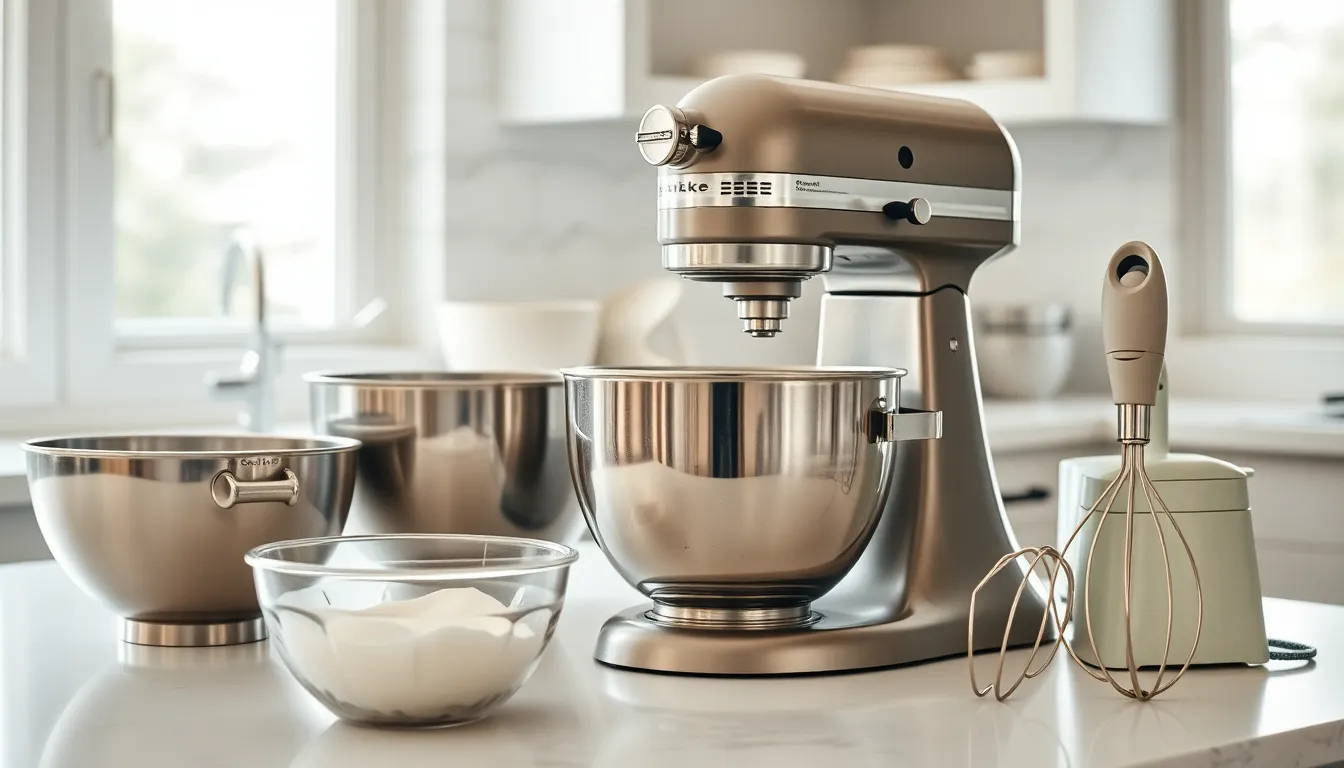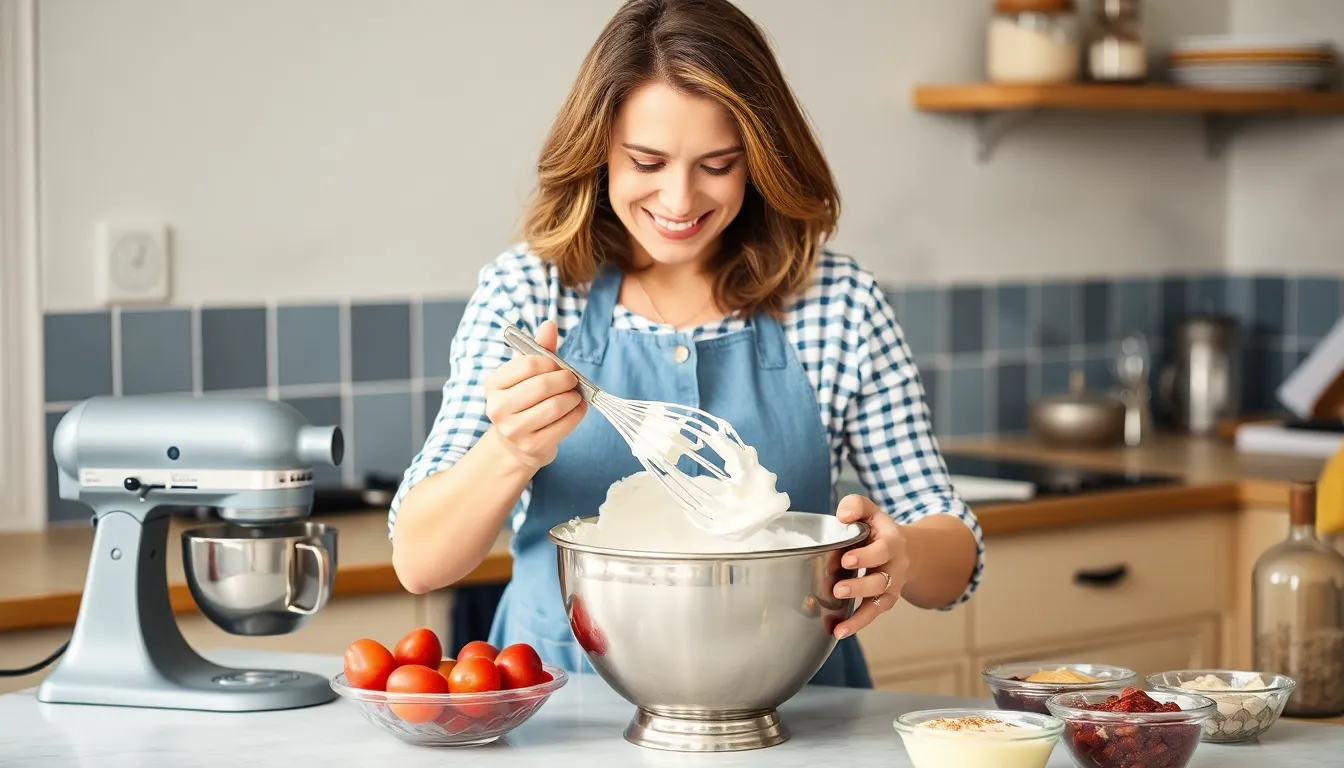Table of Contents
ToggleWhipping heavy whipping cream might just be the culinary equivalent of a magic trick. One minute it’s a silky liquid, and the next, it’s a fluffy cloud ready to elevate desserts from ordinary to extraordinary. Who wouldn’t want to impress friends and family with a dollop of homemade whipped cream that’s so good it could make a store-bought version weep?
Understanding Heavy Whipping Cream
Heavy whipping cream serves as a versatile ingredient in many recipes. Its high-fat content, usually around 36% to 40%, makes it ideal for whipping and creating stable structures in desserts.
What Is Heavy Whipping Cream?
Heavy whipping cream refers to cream with a higher fat percentage than regular cream. This fat contributes to its ability to hold air when whipped, resulting in a rich and fluffy texture. Many bakers use heavy whipping cream for various applications, including toppings and fillings. Its creamy consistency provides a luxurious mouthfeel in finished dishes. Often, it serves as a foundational ingredient in recipes for mousse and ganache.
Different Types of Whipping Cream
Several types of whipping cream exist, each with unique characteristics. Heavy cream contains the highest milk fat, usually 36% to 40%. Whipping cream has a slightly lower fat content, around 30% to 35%. Light whipping cream, on the other hand, contains only 30% fat, making it less stable for whipping. Some individuals prefer coffee cream, which has approximately 18% fat and works well in beverages. Knowing the specific type of cream enhances the outcome in culinary creations.
Tools Needed for Whipping

Having the right tools streamlines the process of whipping heavy whipping cream. Essential equipment includes mixers and bowls that enhance efficiency and results.
Essential Equipment
A stand mixer saves time and effort, delivering consistent results without constant monitoring. Hand mixers offer flexibility, allowing users to whip cream anywhere. Mixing bowls should be stainless steel or glass since these materials resist heat better, which aids in maintaining cold temperatures. Cold tools improve volume and texture, making a noticeable difference in the final product.
Optional Tools for Best Results
Whisks add a personal touch to the whipping process, giving users more control over consistency. Chilled beaters increase air incorporation, contributing to fluffiness. Spatulas assist in folding whipped cream into other ingredients, ensuring even distribution without deflating. Sifters allow integration of powdered sugar or cocoa, enhancing flavor while maintaining texture.
Techniques for Whipping Heavy Whipping Cream
Whipping heavy whipping cream can be accomplished using a few different methods. Each technique offers distinct advantages that cater to various preferences and situations.
Hand Whisk Method
Using a hand whisk allows for greater control over the whipping process. Begin with a chilled bowl and cold heavy whipping cream, which enhances volume. Focus on creating a rapid, circular motion, gradually incorporating air into the cream. Keeping the whisk vertical while moving it in and out of the cream also helps achieve a light and airy texture. Consistency checks ensure that the cream thickens appropriately. Typically, this method takes 5 to 10 minutes, depending on the desired stiffness.
Electric Mixer Method
Utilizing an electric mixer provides efficiency when whipping heavy whipping cream. Choose a medium speed to start, ensuring that the cream remains contained. Use a chilled bowl and cream to prevent overheating, which could impact whipping effectiveness. As the mixer aerates the cream, a gradual increase in speed can enhance volume. Stopping periodically to check for soft peaks ensures that the cream does not overwhip. This method usually requires 3 to 5 minutes for perfectly fluffy whipped cream.
Food Processor Method
Employing a food processor delivers quick results when whipping heavy whipping cream. Start with cold heavy whipping cream, placing it in the processor bowl. Pulsing the machine gives control over the cream’s texture. Switching to continuous operation can incorporate air rapidly, leading to a fluffy outcome. Monitoring the consistency is crucial to avoid overwhipping. In approximately 1 to 2 minutes, the processor can transform cream into an airy topping, perfect for desserts.
Tips for Successful Whipping
Achieving perfect whipped cream requires attention to detail. Following specific tips can enhance the whipping process substantially.
Temperature Matters
Starting with cold heavy whipping cream is crucial. Chilling the cream in the refrigerator ensures it whips up well. Additionally, using a chilled mixing bowl boosts volume and texture. Some experts recommend placing mixing tools in the freezer for several minutes. This preparation can help maintain the desired temperature, resulting in fluffier cream. Avoid warming the ingredients, as warmth can hinder the whipping process and lead to a less stable texture.
Avoiding Over-Whipping
Monitoring the whipping process is essential. Stopping once soft or medium peaks form prevents over-whipping. Over time, cream can transition from fluffy to grainy, diminishing the final product’s quality. Observing the texture allows for greater control, ensuring it maintains a smooth consistency. If it appears too stiff, gently folding in a small amount of fresh cream promotes a balanced texture. Regularly checking the cream’s consistency throughout the process contributes to achieving the perfect whipped topping.
Whipping heavy whipping cream is a simple yet rewarding skill that can elevate any dessert. With the right tools and techniques anyone can create a light and airy topping that rivals store-bought options. The versatility of whipped cream allows it to complement a wide range of dishes from cakes to mousses.
By understanding the nuances of heavy whipping cream and following the tips outlined in the article anyone can achieve perfect results. Whether using a hand whisk or an electric mixer the key lies in maintaining the right temperature and monitoring the whipping process closely. With practice and attention to detail homemade whipped cream can become a staple in every kitchen, impressing friends and family alike.







